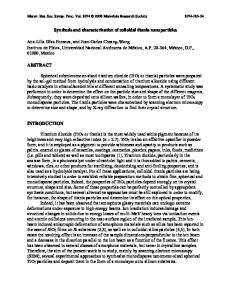Chemical synthesis and characterization of MnO 2 -coated Co nanoparticles
- PDF / 1,184,983 Bytes
- 7 Pages / 584.957 x 782.986 pts Page_size
- 64 Downloads / 413 Views
Zhongyuan Liu State Key Lab of Metastable Materials Science and Technology, Yanshan University, Qinhuangdao 066004, China (Received 7 October 2009; accepted 25 March 2010)
Co/MnO2 particles are synthesized by a simple two-step chemical process. It includes the reduction of Co2þ cations to Co nanoparticles with sodium borohydride (NaBH4) in aqueous solution, followed by coating the sample with a surface layer of MnO2. The coating is accomplished using a simple decomposition reaction, in aqueous KMnO4 solution with acid environment at room temperature. Transmission electron microscopy (TEM) analysis demonstrates that the core of the particles is composed of Co clusters that have a narrow size distribution. The strong interface effect of the Co/MnO2 particles is also studied by the detection of exchange bias phenomena of hysteresis curves. I. INTRODUCTION
Nanosized magnetic materials currently provide a wealth of scientific interest and of potential applications, particularly in the information storage industry.1,2 Recently, nanostructural magnetic materials research has generally been focused on the understanding of the interactions between magnetic entities, modeling of interaction effects, and recognition of the role played by the interface on the magnetic properties of these materials. For such fundamental studies, nanosized particles of ferromagnetic (FM) transition metals such as Fe, Co, and Ni provide better model systems compared with complex alloys since in the latter class of materials it is difficult to separate out different effects that contribute to the magnetic properties.3,4 There are many studies of nanoparticles about core/shell structures, in which some interesting phenomena usually emerge because of the interface effects that result from the structural modification and competition of different magnetic orderings at the interface among them, especially when the cores are ferromagnetic and the shells are antiferromagnetic (AFM). One of the hot topics is the exchange bias (EB) effect, which has recently been studied both theoretically and experimentally.5–11 This effect is characterized with an obvious shift of the hysteresis loop away from the zero point of the magnetic field axis, when the sample was cooled in the field from a temperature above the Ne´el point TN of the AFM phase to below TN. Several experiments have been performed to study the size,12,13 a)
Address all correspondence to this author. e-mail: [email protected] DOI: 10.1557/JMR.2010.0217
1748
http://journals.cambridge.org
J. Mater. Res., Vol. 25, No. 9, Sep 2010 Downloaded: 25 Mar 2015
temperature,5,14–16 and cooling field dependence of the EB field5,14,15 in different FM/AFM nanostructural particles. As the EB effect has extensive applications in magnetic field sensor and read heads, many kinds of FM/ AFM structures have been prepared, such as Co/CoO clusters,5,11 Fe/Fe–oxide systems,6,10,14 and Co80Ni20/ oxide nanocomposites.13 There are a number of techniques that have been developed to synthesize magnetic nanoparticles, su
Data Loading...











